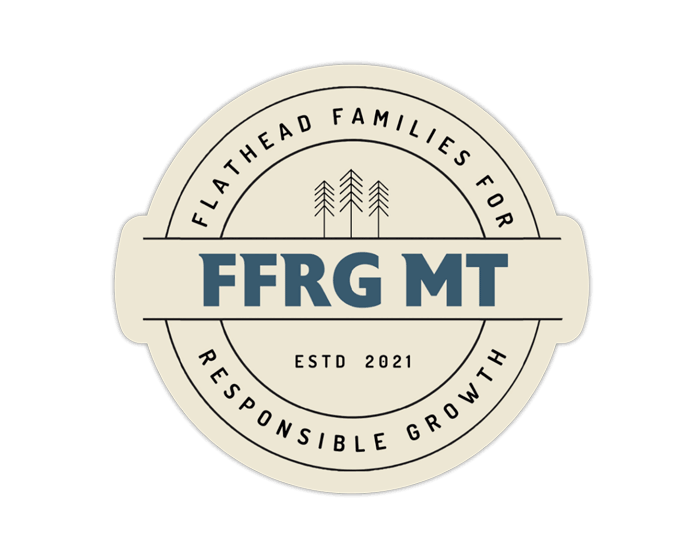
by Julie Engler | May 1, 2023 | flathead sensible growth
The City of Whitefish Planning Department is preparing to begin the process of updating the city’s Growth Policy.
The Whitefish City Council determined the creation of a new Growth Policy, which reflects current and future conditions and ties all subsequent plans together, is prudent. They have made this task a priority goal.
Montana State Statute requires review of a growth policy once every five years, at least. According to the staff report, the existing Growth Policy was last updated in 2007. However, updates like the highway corridor plans and the Downtown Master Plan have been added as recently as 2021.
Prior to their regular meeting last week, the council was treated to a presentation by Whitefish City Planner Alan Tiefenbach about growth policies in general and specific data he gathered as a starting point for creating the new plan.
In his report, Tiefenbach said a growth policy, or comprehensive plan, is an official public document adopted and used by Montana cities, towns and counties as a guide for making decisions about their future, particularly regarding land use.
While a growth policy is not mandatory, the requirements for plans state that a growth policy must be prepared for any city to adopt municipal zoning and that zoning must be consistent with the growth policy.
Additionally, a city’s planning board is the only entity authorized to prepare a growth policy.
According to the staff report, an early step to creating an updated growth policy, or comprehensive plan as they are often called, is to create an inventory of its existing characteristics and features using maps and narrative.
Tiefenbach shared several maps showing the corridor plans, age of structures, location of housing as well as other key elements.
“I drove and I walked every single street in the city and I mapped all the uses at a parcel level. So, I mapped what is actually there now and I compared it to Google Maps and property record data for the state,” Tiefenbach said. “This is a snapshot of what the City of Whitefish looks like.”
In order to encourage community involvement with the Growth Policy, a catchy name was chosen earlier in the month by the planning board. Vision Whitefish 2045 is the new name for the growth policy document.
“Generally, comprehensive plans look out 20 years into the future,” Tiefenbach said. “We’re figuring… we’ll get done with it somewhere late 2024, somewhere early 2025.”
A contest to design a logo for Vision Whitefish 2045, the newly-renamed plan, is in the works and public input during the process of developing the plan is a priority.
Staff has prepared a tentative timeline for the growth policy update process and they
intend to begin “kick-off” and visioning meetings with the public regarding the growth policy update in April and May.
Written by Julie Engler for the Whitefish Pilot. Please view the original story and photo here.

by FFRG Board Members | Mar 10, 2023 | Flathead Families for Responsible Growth, flathead sensible growth, short term rentals
Submitted to the Daily Inter Lake
By Flathead Families For Responsible Growth
| March 7, 2023 12:00 AM
The issues surrounding short-term rentals are not going away.
To the contrary, the problems are increasing as STR growth explodes across the country. Whitefish, Flathead County and the rest of Montana are not immune. Over the last year, Montana has witnessed a 32% increase in vacation rental business and is currently ranked No. 13 in the U.S. in STR occupancy, with over 10,000 listings and 2,846 in Flathead County alone.
But STRs have the potential to significantly alter our small-town feel and permanently change our way of life here. Our lawmakers must keep pace with evolving STR industry and give it thoughtful consideration, thinking beyond state-wide, one-size-fits-all solutions that remove local control. Unfortunately, that is exactly what proposed bills SB 268 and 467 are, and it’s not the answer.
These bills would exacerbate multiple issues surrounding STRs in our communities, not the least of which is affordable housing. We urge Senate members to vote against SB 268 and 467 and ask Montanans to contact their senators to request the same.
Senate Bills 268 and 467 propose to establish STRs as a residential use of a property.
This means that STRs would be allowed in every zoning district in Whitefish and in all towns and cities across the state that are zoned residential, even if currently prohibited by HOAs. Whitefish would no longer be limited to the 5-6 areas currently zoned for STRs, which is of primary concern to us.
As proposed, SB 268 and 467 benefits a minority of individual property owners and investors engaged in VRBOs/Airbnb’s. However, the rest of us will have to live with the consequences of fewer long-term rentals and affordable housing options, which will worsen the already critical shortage of worker housing.
Tourist demand fuels the conversion of existing housing stock into short-term rentals.
This will be especially true in communities like Whitefish where tourist demand fuels the conversion of existing housing stock into STRs.
Past arguments in favor of STR residential classification have focused on what is being done on premises, not how long. This interpretation concludes that STRs are being used for ordinary living purposes such as sleeping and eating, which is consistent with the definition of “residential purpose.” If so, hotel use could also be considered a residential purpose. A more reasonable interpretation would hold that STRs with a rental period of 30 days or less amount to hotel use, and thus are commercial in nature.
Further, how can STRs be considered residential and not commercial when they are required to be permitted, often inspected and must collect and pay hotel lodging taxes? Such an approach would be inconsistent and haphazard. STRs must be defined as lodging/commercial-use businesses, which would prohibit them from residential areas not zoned for STRs.
The impact of short-term-rentals effects housing prices and the cost of rent
Sen. Greg Hertz says that he has not seen any studies providing evidence that STRs negatively impact the availability and affordability of workforce housing. Clearly, he is not looking hard enough.
The state of Montana may not have commissioned such a study. But there are plenty of studies across the country that assess the impact of STRs on housing prices and rent. Several reputable organizations, such as the Pew Charitable Trusts and the Harvard Business Review, have conducted or published research showing definitively that as the number of a community’s STRs increase, the quantity of affordable housing units decreases.
Short-term rentals contribute to the Flathead housing availability crisis
Affordable housing impacts caused by the conversion of long-term housing to STR use are such a concern that in December 2021, Aspen, Colo. took the dramatic step of enacting a one-year STR moratorium. Aspen used that time to create a new framework of ordinances supported by management technology with the intent of lowering the negative effects of STRs (results of the city’s work have not yet been announced).
Senator Hertz also believes that SB 268 will give local workers the ability to purchase a home and perhaps use an accessory studio on the property as an STR to help them pay for the property. If so, (perhaps this should be part of a state-sponsored study) as long as that property owner can rent that accessory studio as an STR for a premium over long-term rent rates, it effectively reduces the availability of affordable housing.
Short-term rentals create a cycle of less affordable housing in the Flathead
SB 268 makes no effort to address the tourism/STR conundrum, but rather fuels a catch-22: The more STRs, the more dollars from the hotel tax collected from STRs can be spent on tourism, which attracts more STRs. However, at the same time, there is even less affordable housing needed to support the growth in tourism.
Perhaps the lawmakers should explore increasing the lodging facility use tax and/or changing the property tax to a commercial rate on STRs, as other resort communities across the country have done. Those funds could be redirected to support affordable housing and local STR enforcement, which is woefully inadequate in Flathead County.
SB 268 and 467 are an ineffective legislative approach that benefits only STR owners and does nothing to protect the property rights and character of our community.
We need to do better!
If you have concerns about SB268, please contact your state representative.
Flathead Families for Responsible Growth board members include Jeffry Allen, Carol Balliet Atkinson, Brad Bulkley, John Collins, Murray Craven, Richard Hildner, Carolyn Pitman, Cameron Blake and Connie Cermak.


